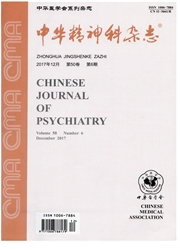

 中文摘要:
中文摘要:
目的探讨广泛性焦虑(GAD)患者、惊恐障碍(PD)患者对情感刺激的脑反应模式差异。方法首次发病、未经治疗的12例广泛性焦虑患者(GAD组)、13例惊恐障碍患者(PD组)和13名对照者(对照组)对情绪图片愉悦度等评分,并在被动注视任务下行功能磁共振成像(fMRI);被试者依次完成3个任务(分别为正性、中性和负性任务)的fMRI检查。采用全脑分析方法,比较GAD组和PD组大脑在正性、中性和负性情绪图片任务组块问的血氧依赖信号(BOLD)强度反应特征。结果(1)在正性情绪任务条件下,GAD组右中央后回和左顶上小叶强于PD组(强度差异分别为0.2361和0.1289,P均〈0.01);左侧扣带回、右中央前回和右岛叶弱于PD组(强度差异分别是0.1623、0.1557和0.3491,P均〈0.01);(2)在中性情绪任务条件下,左颞下回、左顶下小叶和右岛叶GAD组强于PD组(强度差异分别是0.2725、0.1459和0.4398,P均〈0.01),右侧岛叶和右侧杏仁核弱于PD组(强度差异分别是0.5967和0.3600,P均〈0.01);(3)在负性情绪任务条件下,在右额上回、左侧顶下小叶、右侧梭状回、右下半月叶和右岛叶,PD组强于GAD组(强度差异分别是0.6301、0.1896、0.4047、0.2788、0.6713和0.3569,P均〈0.01);无脑区BOLD信号强度弱于GAD组。结论2种焦虑障碍亚型在情绪图片处理过程方面可能存在不同模式,PD以经典的情绪环路为主,GAD主要与额叶等高级神经中枢活动调制异常有关。
 英文摘要:
英文摘要:
Objective To explore the different behavioral and related whole brain response to emotional pictures in individuals with generalized anxiety disorder or panic disorder (PD). Methods Functional magnetic resonance imaging (fMRI) was adopted to examine the neural substrates of emotional pictures processing in 12 first-episode unmedicated GAD subjects, 13 first-episode unmedicated PD subjects (PD) and 13 healthy controls (HC). Analyses focused on the blood-oxygen level dependant (BOLD) signal intensity change in the whole brain across blocks of positive, neutral and negative emotional pictures in PD versus GAD. Results ( 1 ) For positive pictures task, individuals with GAD showed stronger response in right postcental gyrus and left superior parietal lobule than ones with PD( activation difference in 0. 2361 and 0. 1289 respectively, both P 〈 0. 01 ) , and weaker response in left cingular gyrus, right precentral gyrus and right insular gyrus ( difference in 0. 1623,0. 1557 and 0. 3491, all P 〈 0. 01 ). (2) For negative pictures task,individuals with PD presented stronger response in the right superior frontal gyrus, left inferior parietal lobule, right fusiform gyrus, right inferior Lobulus semilunaris and right insular gyrus (difference in 0. 6301, 0. 1896, 0. 4047, 0. 2788, 0. 6713 and 0. 3569,all P 〈0. 01 )than ones with GAD. (3) For neutral picture task, GAD individuals showed stronger response in left inferior temporal gyrus, left inferior parietal lobule and right insular gyrus than PD ones( difference in 0. 2725,0. 1459 and 0. 4398, all P 〈 0. 01 ) , and weaker response in right insular lobular and right amygdale ( difference in 0. 5967 and 0. 3600, all P 〈 0. 01 ). Conclusions The two kind of anxiety disorder present different response model to emotional pictures, with panic disorder majoring in classical circus of emotion while generalized anxiety disorder in high central neural system such as frontal lobe.
 同期刊论文项目
同期刊论文项目
 同项目期刊论文
同项目期刊论文
 期刊信息
期刊信息
